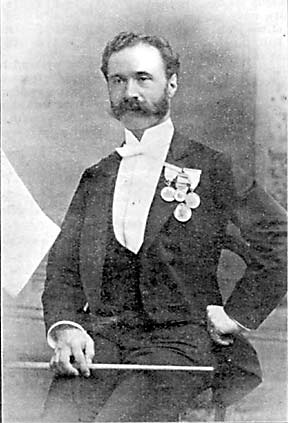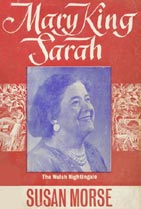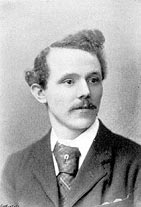Culture - Music
Dyffryn Ogwen
The incredible development of choral singing in the Bethesda
area between 1838 and 1862 was the work of four quarrymen and was
rooted in the Temperance Movement. William Morgan of Braichmelyn
formed a temperance choir around 1850 that toured areas of Wales
and England, before performing at Exeter Hall, London in 1851.
However, Morgan and a large number of his choristers decided to
emigrate to Slate Valley, Pennsylvania in 1852 and the choir
lapsed.
Two others who made a substantial contribution were Griffith
Rowlands, Asaph, (1807-99) and his pupil, David Roberts, Alawydd, (1820-72) the former being in charge of congregational
singing at Bethesda Chapel and the latter training the choir of
between 80 and 100 members. Of course, it must also be borne in
mind that the choral tradition in the chapel went back as far as
1833.
The fourth was Owen Davies (Humphries), Eos Llechid,
(1828-1898). He was responsible for conducting a hand picked
voice church choir of only twelve choristers to perform parts of
'Messiah' to Queen Victoria and her entourage at Penrhyn Castle
in 1859. He left the quarry in 1863 and was subsequently ordained
in the Church of England.
Three years previously, a choir a choir of 500 had sung Messiah on the floor of the Penrhyn Quarry, conducted by
Griffith Rowlands, David Roberts and Owen Davies to the
accompaniment of the Royal Penrhyn Band with between 12,000 and
15,000 listeners in the various 'ponciau.'
A further reflection on this musical activity was that by
1864, the printing press of Robert Jones, Bethesda was printing
music in old notation.
Roland Rogers (1847-1927)
Roland Rogers, right, who spent two periods as organist at
Bangor Cathedral, broke the mould of the amateur musician as
choirmaster, in the early 1880's in Bethesda. Added to this,
despite the fact that he was a monoglot Englishman was in great
demand as a choirmaster and gymanfa ganu conductor. He was
invited to conduct a mixed voice choir at Bethesda and triumphed
three times in succession between 1884 and 1886 at the national
Eisteddfod. He had to be content with sharing the laurels with
Huddersfield Mixed Voice Choir in 1887.
Male voice choirs
A male voice choir from the Penrhyn Quarry went to compete at
the 1874 National Eisteddfod at Bangor. It appears that all
energies in Bethesda then went into mixed choral singing until
1891-92, when it was decided to send a choir to compete at the
World Fair Eisteddfod at Chicago in 1893. But the colliers of Cwm
Rhondda beat the quarrymen. Edward Broome (1868-1930) from
Bangor conducted the choir. He decided to go to Canada instead of
returning straight away to Bethesda. However, he did return the
following year to conduct the choir to victory at the Caernarfon
National Eisteddfod. He then returned to Canada where he spent
the rest of his life as an accomplished and respected musician at
Toronto.
The Penrhyn Choir from 1935 onwards
There were seven separate male voice choirs in seven of the
quarry galleries by 1934. Before the end of the year it was
decided to amalgamate them to form one choir. The following year,
David Jones conducted them to victory at the 1935 National
Eisteddfod at Caernarfon. W. Ffrancon Thomas (1898-1972) took
charge in 1938, but any further development was stifled by the
1939-45 war. But following a spectacular victory at the Colwyn Bay
National Eisteddfod in 1947, which was repeated in 1948 and 1949,
the choir went and is still going from strength to strength with
foreign tours, including a centenary return to Chicago in
1993.
The 1896-97 Strike Choirs
A special feature of the 1896-97 and the 1900-03 strikes were
the ladies and male voice choirs that were formed to raise funds
by performing in Wales and England.
By March 1897, one of the male voice choirs had reached
Brighton and gave a spectacular concert at the Dome that lasted
for two and a half hours. It resulted in a collection of over
£120.00. The following day the choir left for Maidstone.
A section comprising of ten members were invited to perform in
Liverpool and Manchester after touring north-east Wales. On
reaching Aberdyfi, they accepted an invitation to London. The
number of singers was increased to 30. They reached London on
January 20th, 1897 and by the end of their last concert there on
February 16th, they had collected over £1,000 towards the strike
fund.
The Choirs of the Great Strike,
1900-03
It was during this strike that a ladies choir was formed for
the first time, with Jeremiah Thomas, one of the men dismissed
from the quarry in 1896 acting as their treasurer. From his
diaries, concerts were given in north-east Wales from January 1st
to the 23rd. Three days later they were in London, where they
spent the next six weeks giving at least one concert and
sometimes two in a day. Time was taken on February 2nd, when
Jeremiah Thomas noted that he had stood still in the same spot
for five hours to see Queen Victoria's cortege passing by.
Dyffryn Nantlle
Once again, the choral tradition at Nantlle, as in all the other
areas, was rooted in the fact that the local headmaster, fresh
from the Normal College, Bangor, would hold music classes.
Hugh Owen (1832-1897) migrated to Dyffryn Nantlle to work as a
cobbler, but he seems to have spent a considerable amount of time
travelling in England with the Tal-y-sarn Glee Singers. The
singers won the first prize at the Porthmadog Eisteddfod in
1871.
His son, Richard Griffith Owen (1869-1930) Pencerdd Llyfnwy
followed his father's footsteps as a musician, but also made a
name for himself as an orchestral arranger. He formed a small
orchestra, which added to the wealth of music to be heard in the
valley.
By 1894, Dyffryn Nantlle Male Voice Choir and Tal-y-sarn
Children's Choir were competing at the National Eisteddfod. J.
Owen Jones conducted the male voice choir by 1902, who by
coincidence was also the conductor of the Ladies Choir during the
Great Strike.
C.H. Leonard was a physics master at Brynrefail School by the
early 1930's, when he was persuaded to form a male voice party of
twelve members. This was the idea, which led to the formation of
the Dyffryn Nantlle Male Voice Choir that made its name especially on the radio
programme Noson Lawen in the 1940's and
1950's.
One cannot either forget about the Cerdd Dant tradition
embodied in the singing of the Francis Brothers. Griffith
William Francis (1876-19 ) and Owen William Francis (1879-1936)
were regular broadcasters on Radio Athlone years before the BBC
studios were set up at Bangor.
The Ffestiniog area
The Blaenau Ffestiniog Philharmonic Society went to give their
services to the Porthmadog Eisteddfod of 1851, a society that was
still in existence until at least 1868. A choir was also formed
under the banner of the temperance society, The Good Templars in
the 1870's.
A very important figure in the development of choral singing
in Blaenau Ffestiniog from 1875 onwards was Cadwaladr Roberts
(1854-1915.) Like so many others, he started his career in his
local chapel and conducted the Blaenau Ffestiniog Choral Union at
the 1884 National Eisteddfod. Further, he took them to sing at the Crystal
Palace in 1892. From 1886 onwards, he also conducted the Tanygrisiau Male Voice Choir as well as the Moelwyn Male Voice
Choir. He was the obvious choice as conductor for the 1898
National Eisteddfod Choir.
Come to America
By 1909 Cadwaladr Roberts had set his sights on taking a male
voice group over to the United States to perform. However, he was
faced with one overriding problem: he had to whittle his
choir of between 70 and 80 voices down to a mere 24. A thorny
and explosive situation!
He voice tested everyone, and they all sailed off
together with Mary King Sarah as guest soloist and Jennie Parry
(1874-1917) Telynores Lleifiad as guest harpist. Once they had
departed J.T. Owen a rising star in Blaenau Ffestiniog musical
activities, and who had already taken a ladies choir to compete
at the 1909 National Eisteddfod in London, took hold of Cadwaladr
Roberts' 'rejects' and formed a new male voice choir! On his
return to Blaenau, Cadwaladr Roberts had enough clout to reunite
his choir.
Cadwaladr Roberts returned twice again to the United States to
collect funds for the Society for the Eradication of
Tuberculosis. He was suffering from the disease when he returned for
the last time. By 1912, J.T. Owen had his Blaenau Ffestiniog Male
Voice Choir on a firm foundation.
The choral tradition was kept alive in the years between the
two world wars and a representative choir from the town
participated at the annual Harlech Festival. After 1945, the Oakeley Male Voice Choir was formed (re-named Côr y Moelwyn in
1961) whilst Côr y Brythoniaid, the largest ever to be founded in
Blaenau was set up in 1964.
Between 1932 and 1974, Côr Rhianedd y Moelwyn also gained a
reputation for themselves as a choir of high standards.
Cerdd dant
Gwenllian Dwyryd had a cerdd dant choir, Côr Cynfal in the
locality as well as numerous concert parties. Reference must also
be made to David Francis (1865-1929) The blind harpist of Meirion who was born in a small cottage in Llechwedd Quarry. In
Dyffryn Nantlle, both Mallt and Llyfni Hughes kept the old
traditions alive during 1930-50's.
Music and poetry about the quarry and the
quarrymen.
Very little original music was written and produced about the
quarryman. A solo was composed by John Jones Eos Bradwen Y Gwr
a'r Siaced Wen whilst David Jenkins composed a male voice piece
'The Quarrymen's Chorus'.
Yr Hen Dalcen Mawr
This was a very famous green granite pillar that stood in the
Penrhyn Quarry. Around 1815 it was part of a large rock outcrop
that stood at its base. Workmen quarried through the base over
the years to gain entry from one part of the quarry to the other.
The large pillar of rock was left standing as an
attraction more than anything else. Its condition had
deteriorated so much that it was demolished on April 27th, 1895,
using seven tons of powder. It was believed that around 125,000
tons of rock was demolished.
Eos Bradwen subsequently wrote a quartet to celebrate the
occasion.
Three international singers from the
slate quarry areas:
- D. Ffrancon Davies (1855-1918)
David Davies' father was in charge of the Penrhyn Foundry,
but both he and Gwen his wife were able to send their son to
Friar's School, Bangor. Subsequently, with the help of a
scholarship, he attended Jesus College, Oxford, where he graduated in
1881.
He was later ordained in the Anglican Church, and served
at the stone quarrying village of Trefor from 1884, before being
appointed curate at Gyffin, near Conwy. By now he had received
musical tuition from Roland Rogers and decided to pursue a
musical career.
After a period at the Guildhall School of Music, he had started
on his career as a soloist. Having started in the operatic field,
he changed to the world of oratorio. Within six years, he was
touring in the United States. On returning to Europe,
he settled down at Berlin with his family in 1898.
He developed into one of the greatest oratorio soloists
specialising in the works of Edward Elgar, who
became one of his greatest friends. He returned to London in 1902
able to sing in eight different languages and two years later was
appointed to the Royal Academy of Music.
Losing his only son in 1908 had a traumatic effect upon him and
for the last decade of his life suffered from severe mental
problems.
Margaret Jane Parry was born at 2 Douglas Terrace, Bethesda. Following
tuition by John Samuel Williams Pencerdd Ogwen (1852-1926), she
then went to Roland Rogers and R.S. Hughes (1855-1893). Having
won over three hundred and fifty eisteddfod prizes, it was no
wonder that Megan Llechid won the open soprano solo competition
at the Blaenau Ffestiniog National Eisteddfod of 1898.
Two years later, all her plans like many others of her
generation were in ruins because of the Great Strike. She
subsequently found herself a member of the ladies choir who
toured raising cash for the strike fund. They spent six months in
London and the south of England in 1901 and raised over
£3,500.
After the end of the strike, she and her family settled down
in Holyhead. After marrying she spent eight years in Edinburgh
before moving down to London in 1920. From there she went to
Italy for further tuition and Madam Telini was born. Between
1927 and 1934 she had a very busy concert schedule in London and
released sixteen records before retiring in 1934 to run a small
hotel. She and her husband moved to Pembre when war broke out
and it was there that she died in 1940 and buried in
Holyhead.
- Mary King Sarah (1884-1967)

Tom Sarah, her father, served as conductor of the Royal Nantlle
Vale Brass Band for twenty-five years and he and Sarah, his wife,
brought up their five children in the world of music that existed
at Tal-y-sarn and the area at that time.
By the turn of the century Mary was a member of the Dyffryn
Nantlle Ladies Choir, the Dyffryn Nantlle Mixed Voice Choir and
the Caernarfon Operatic Society. When the National Eisteddfod was
held at Caernarfon in 1906, she won the open soprano competition,
the open mezzo-soprano competition and the open duet
competition.
For the next three years she was kept exceedingly busy on a
gruelling concert schedule before signing a contract to accompany
the Moelwyn Male Voice Choir on a five-month tour of the States.
On completion of the tour, she decided to settle down in the
States rather than return to Wales, staying at first with
relations in Wisconsin. Her parents and two of her sisters joined
her in 1912.
For the rest of her life Mary King Sarah was a firm supporter
of all Welsh musical and cultural activities in the United
States. She came home on two occasions, in 1947 and 1959.
- E.D. Lloyd, 1868-1922

At the turn of the twentieth century E.D. Lloyd, right, was
regarded as an important composer and voice trainer. Born at
Highgate, Llan Ffestiniog, he spent eight years in the quarry
before spending some time at the Royal Academy, London in 1890
when he was appointed organist at Charing Cross Chapel. Following
R.S. Hughes's death in 1893, he was appointed organist at Bethesda.
Lloyd was in great demand as a conductor and adjudicator as well
as holding weekly classes at places like Bangor, Llangefni and
Holyhead. It was he who first taught 'Cavan Jones', (1887-1945)
from Holyhead, who would become one America's most popular
baritones as well as Ifor Thomas, (1892-1956) from Pentraeth who
would in time sing in opera houses at Paris, Monte Carlo, Nice,
La Scala and the Met.
After many visits to the States, Lloyd decided to emigrate in
1914, spending short periods at Sherburne, Detroit and South
Bend, Indiana. He moved to Philadelphia in 1918, where he died
four years later.
|